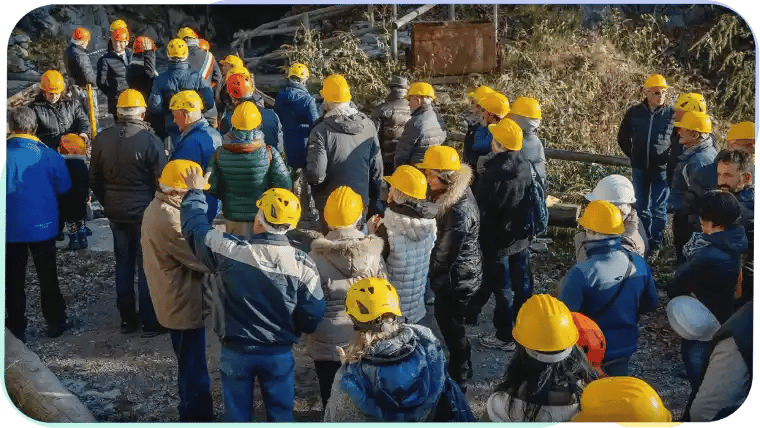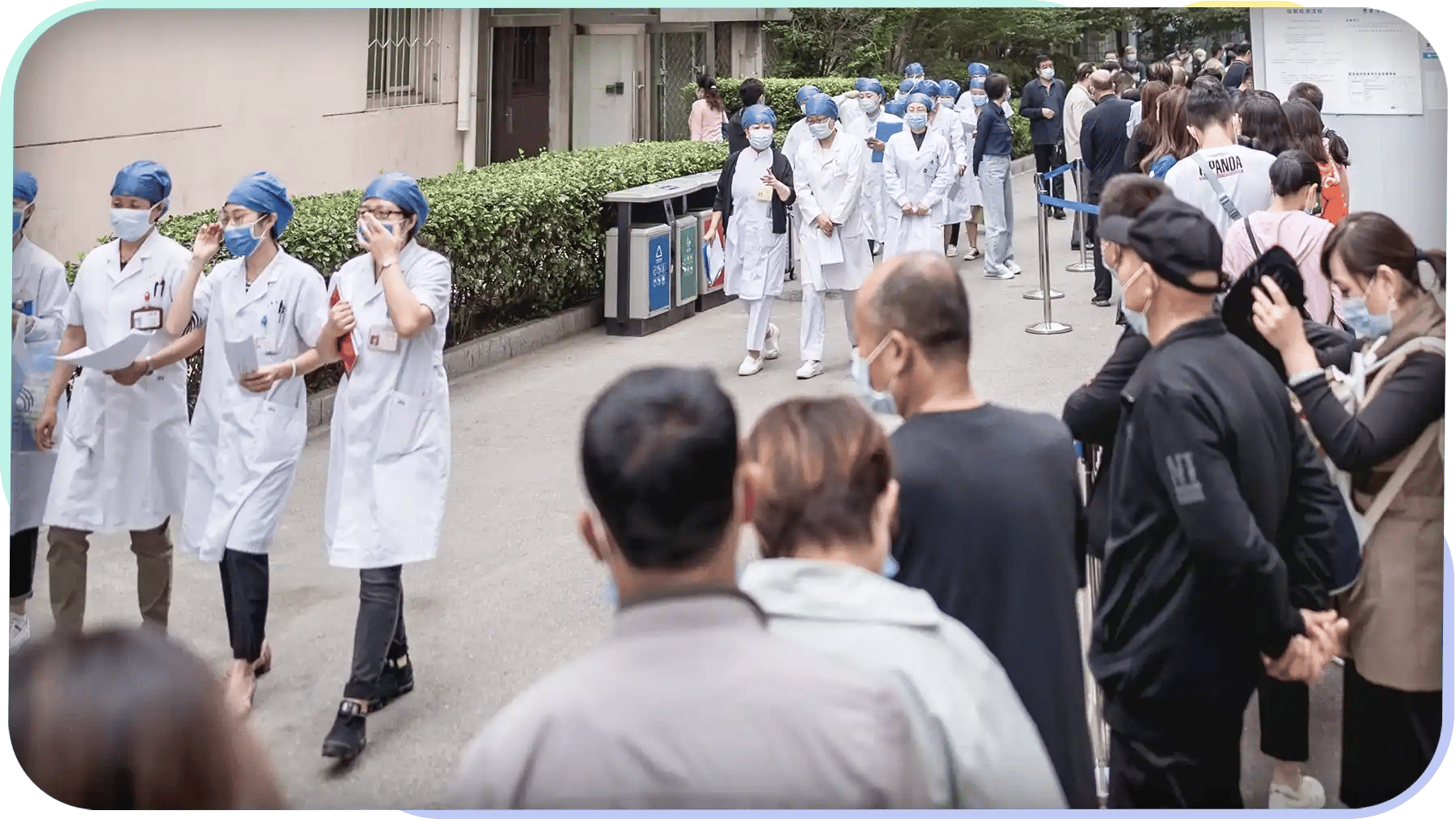- Products
- Use Cases
- Process contractors and validate credentials
- Improve facility compliance to industry standards
- Improve speed of visitor check-in process
- Screen visitors or restrict access to my facility
- Automate my reception experience
- Improve and automate my facility evacuation process
- Manage facility security across multiple locations
- Industries
- Pricing
- Resources
- Company
Muster Point Meaning & Best Practices: Emergency Management FAQ
October 11, 2022
During workplace safety training or while passing work or construction sites, you may have seen signs reading "muster point" or muster zone." Although the terms sound unfamiliar or like something you might put on a hot dog, we all know about mustering – if not necessarily under that name.
As students, every school practiced fire drills. When you and your classmates evacuated the building, your teacher had a specified area where you would all meet for roll call. This meeting area is a muster point, and mustering is the act of assembling at the muster zone.
What is the Meaning of Muster Point
A muster point is the designated location you assemble after an emergency evacuation. A good muster point fulfills three functions:
Safe emergency mustering requires distance. Evacuees should gather far enough from the emergency's point of origin that they are not still at risk. For this reason, managing distinct types of emergencies and conditions may require different muster points.
For example, a Hazmat incident may release toxic gasses that can travel in the wind. If this occurs, wind direction may affect the ideal location for mustering.
The meeting point should also be free from other potential threats. Ideally, that means clear of obstructions, potential dangers like utilities or power lines, dangerous machinery or equipment, and other buildings where fires could spread. An uphill location is worth considering if your workplace has a high risk of flooding or Hazmat spills.
An accessible muster point is essential to ensure evacuees can get to the location. While the distance from the threat matters, the zone should be close enough for rapid emergency mustering. You want all employees and visitors to reach the area quickly and safely.
Another consideration for access is the route to the mustering destination. The evacuation route should be as short as possible, unimpeded, uncomplicated, and have minimal potential hazards along the way.
To this end, health and safety officers should also consider accessibility for people with physical disabilities or other challenges while establishing muster points and routes. If wheelchair access is impossible, you may need to install ramps or provide alternate routes.
Finally, performing a headcount, or roll call, is how safety officers know that everyone has evacuated safely. Manual headcounts require a designated person to perform them at each muster point. This person confirms that each person is safe or communicates any missing persons asap.
The more effective option is digital mustering software, sending emergency notifications directly to evacuees. Sending digital headcounts allows for immediate response, indicating safety or a need for assistance. This tool clears up confusion as it accounts for people who aren't in the building that day, visitors who may not be accounted for during a manual roll call, or people who had to exit to a different muster point than assigned.
Purpose of Mustering
The purpose of a mustering point is to give evacuees a known place to assemble. It gives a safe location for evacuees and identifies if anyone is missing or trapped inside. Having a known, familiar location to meet reduces confusion during the chaos of an emergency. Evacuees already know the steps to follow and where to go. This preparedness makes evacuations safer, faster, and easier to manage.
Taking roll calls at the muster point helps emergency responders react more effectively. It directs their search efforts and can serve to highlight potential risk areas. As a result, people can be rescued faster, and emergency resources are used more efficiently.

Emergency Mustering & Muster Point Best Practices
Effective facility emergency management planning is proactive and comprehensive. Plans should consider all likely hazards and risks and the different software, strategies, and personnel available to mitigate risks or manage emergencies. Examining these factors is important for choosing the best emergency mustering strategy.
This section explores some best practices for managing mustering and muster points in complex facilities.
Communication
Coordination and collaboration are vital to any process in the workplace. Nowhere is this more critical than during an emergency. Keeping everyone up to date and on the same page stems from solid communication.
During an emergency, communication is vital. For most people, that first communication is the lights and sounds of emergency alarms. Safety officers also need to be in contact with each other to communicate updates, headcounts, and any other relevant information.
Digital mustering tools can further enhance communication. Send out mass notifications to everyone in your building with critical information:
- Evacuation routes
- Muster points
- Emergency type/details
Digitized mustering also allows for more advanced headcounts. Enabling two-way communication allows individuals to respond directly to roll calls. Evacuees can provide status updates, letting you know they are safe, trapped, or requesting assistance.
Communication doesn't start when an emergency occurs. Make efforts from the get-go to keep everyone in your building informed of emergency procedures and muster points. Employee orientation and onboarding should include knowledge of evacuation routes, procedures, and emergency mustering. Each floor should have designated maps showing evacuation routes and muster points. Electronic visitor management systems can include safety videos during sign-ins. And all of this should be reinforced with practice, practice, practice.

Schedule Emergency Drills
Every workplace needs to schedule and run emergency drills. Practice familiarizes the workforce with muster point locations and evacuation procedures. If an emergency occurs, everyone knows what to do.
The standard rule in most places is a minimum of one fire drill every twelve months. In facilities with elevated fire risks, that can increase to once every three months. Of course, the unique risks of a given facility, region, or industry affect the frequency and types of drills a given workplace requires.
Assign Roles
Managing workplace emergencies requires clear SOPs and organizational structure. Successful mustering has defined roles within that structure. Roles may be assigned to EHS, security teams, or individual floor and departmental safety officers.
When an emergency occurs, this ensures protocols are followed and optimizes communication. A chain of command within these roles improves unified efforts if evacuation plans or muster points need to change.
Flexibility
Emergencies are dynamic - they happen fast and can change in an instant. An effective workplace emergency response needs to be flexible. While developing SOPs for every possible outcome and disaster is not practical, a versatile plan allows for an adaptive response.
One way to keep employee evacuations and emergency response flexible is to have alternative muster points. If one muster zone is no longer safe, for example, if a power line goes down in the area, people need somewhere else to gather. Alternatively, if the route to the dedicated mustering point is blocked or unsafe, employees may be better off going to a backup zone.
Communicate any alternative muster points in advance. It's good practice to incorporate their use into drills. During an incident, use an emergency management app to send mass notifications, updating any changing muster point information.

Digital Mustering
Digitized mustering automates facility evacuations in real time. Send out mass emergency notifications and alerts to everyone in your building, providing vital information like muster point locations. Conduct roll calls via SMS and mobile apps and compares against evacuation lists for rapid headcounts.
Removing manual processes from mustering means faster evacuations, stronger communication, and safer facilities.
Emergency Management Software
Effective, responsive mustering requires emergency software built directly into your facility management platform. This synchronizes management efforts across your building or even multiple locations.
ILobby's Emergency Management System, EmergencyOS™, is a module within the FacilityOS™ platform. This gives your mustering efforts access to tools like visitor management, so you know who is in your building. This combination means you can contact visitors with mustering info and headcounts who may not otherwise be trained on drills or muster point locations.
Another advantage of an all-in-one system is that handling emergencies, like all your management efforts, is done through one central online portal. That means EHS and security can manage emergencies from anywhere, even offsite. Headcounts and roll calls can be sent through kiosks or automation, as well as via smartphone or computer.
Also, having EmergencyOS™ explicitly designed for the FacilityOS™ platform means reliability. If an emergency occurs, you need to trust that your software stack functions together seamlessly.
Discover how EmergencyOS™ is transforming workplace mustering. Book a demo today and discover the iLobby difference.
Related Posts
View All Posts
Emergency Management
6 min read
Effective Emergency Planning: A Five-Step Guide to Ensuring Safety & Compliance
Continue Reading
Guide
13 min read
The Complete Enterprise Emergency Management Guide
Continue Reading
Emergency Management
5 min read

